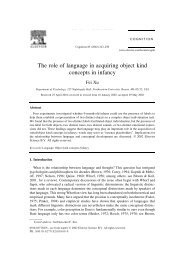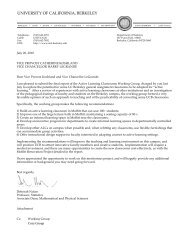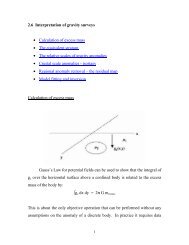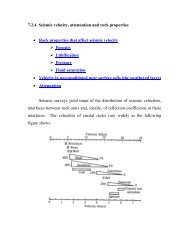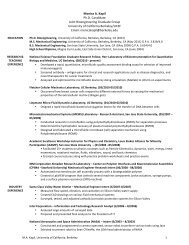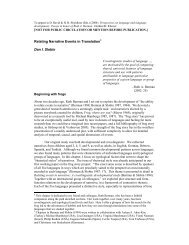Photonic Crystals: Semiconductors of Light - Yablonovitch Research ...
Photonic Crystals: Semiconductors of Light - Yablonovitch Research ...
Photonic Crystals: Semiconductors of Light - Yablonovitch Research ...
Create successful ePaper yourself
Turn your PDF publications into a flip-book with our unique Google optimized e-Paper software.
NATURAL PHOTONIC BAND GAPS occur in some butterfly wings (left) and in<br />
opals (right). In both cases, the band gap is incomplete—it is not effective<br />
in every direction—but it produces iridescent colors. A micrograph <strong>of</strong> a<br />
fractured iridescent green butterfly scale (center) shows the submicronsize<br />
face-centered cubic structure inside. Opals consist <strong>of</strong> submicron-size<br />
silica spheres arranged in a face-centered cubic (close-packed) structure.<br />
PAUL BEARD (left); HELEN GHIRADELLA, FROM THE ANNALS OF THE ENTOMOLOGICAL<br />
SOCIETY OF AMERICA, VOL. 78, 1985 (center); THE PURCELL TEAM Corbis ( right)<br />
defects to a band-gap structure is comparable<br />
to doping in an electronic semiconductor<br />
and opens up a vast range <strong>of</strong><br />
functions. One example <strong>of</strong> a dopant is<br />
the central hole in photonic crystal optical<br />
fibers. Similarly, plugging one <strong>of</strong> the<br />
holes in a thin-film crystal produces a<br />
critical element <strong>of</strong> lasers, namely a small<br />
“cavity” that can hold a local electromagnetic<br />
mode—imagine a little standing<br />
wave <strong>of</strong> light trapped between mirrors.<br />
Recently Axel Scherer’s group at the California<br />
Institute <strong>of</strong> Technology used these<br />
tiniest <strong>of</strong> optical cavities to make lasers<br />
just 0.03 cubic micron in volume, the<br />
smallest ever.<br />
Patterning photonic crystal thin films<br />
into optical circuits would represent the<br />
ultimate limit <strong>of</strong> optoelectronic miniaturization.<br />
Many researchers believe that<br />
integrated circuits that combine conventional<br />
electronics and photonics stand<br />
ready to extend the integrated-circuit revolution<br />
into the domain <strong>of</strong> high-bandwidth<br />
optical signals. This field <strong>of</strong> bandgap<br />
device development will probably<br />
draw the most attention in the next few<br />
years, but commercial products are still<br />
two to three years away.<br />
You might not expect electromagnetic<br />
band-gap crystals to be <strong>of</strong> much use for<br />
radio waves, because excessively large<br />
crystals would seem to be required. Cellular<br />
telephones, for example, may use<br />
radio waves that are 35 centimeters long<br />
in free space or in air. A crystal with<br />
many holes or rods <strong>of</strong> that size and spacing<br />
would hardly be portable. We are rescued<br />
by the common LC circuit <strong>of</strong> electronics,<br />
which combines an inductor (a<br />
coil; “L”) and a capacitor (parallel plates;<br />
“C”). Such a circuit can, in effect, cram<br />
an electromagnetic wave into a small volume.<br />
An array <strong>of</strong> LC circuits can behave<br />
as a photonic crystal and control electromagnetic<br />
waves that have free-space<br />
wavelengths much larger than the array.<br />
MORE TO EXPLORE<br />
Backward <strong>Light</strong><br />
SHELDON SCHULTZ and David R.<br />
Smith, both at the University <strong>of</strong> California<br />
at San Diego, used arrays <strong>of</strong> LC circuits<br />
to create “left-handed” materials,<br />
which have a negative refractive index at<br />
microwave frequencies. In these materials,<br />
electromagnetic waves travel backward:<br />
when the wave crests are moving<br />
from left to right, the energy <strong>of</strong> the wave<br />
is actually traveling from right to left!<br />
John B. Pendry <strong>of</strong> Imperial College in<br />
England has used LC electromagnetic<br />
band-gap arrays for manipulating the radio-frequency<br />
magnetic fields used in medical<br />
magnetic resonance imaging. Collaborations<br />
<strong>of</strong> researchers from industry, the<br />
military and academia (including my<br />
group) are studying how LC resonator arrays<br />
can also be used for controlling radio<br />
waves. Possible advantages <strong>of</strong> such arrays<br />
include making GPS antennas more precise<br />
by suppressing signal reflections from<br />
Earth and increasing cell-phone handset<br />
efficiency by reducing the electromagnetic<br />
coupling to the user’s head.<br />
It appears likely that these LC circuit<br />
concepts can be extended back down to<br />
optical wavelengths. These devices would<br />
use plasmons, which are currents oscillating<br />
at optical frequencies on metallic<br />
surfaces. Such tiny LC circuit arrays,<br />
smaller than an optical wavelength, may<br />
represent the ultimate end point <strong>of</strong> photonic<br />
crystal miniaturization.<br />
Sometimes venturers need to be overconfident,<br />
or they would never set <strong>of</strong>f on<br />
their quests and persevere to the finish.<br />
When I pause to consider the extent <strong>of</strong><br />
activity in this field today, I am very glad<br />
that a decade ago I took those distressing<br />
phone calls as an appeal for further research<br />
and problem solving.<br />
<strong>Photonic</strong> <strong>Crystals</strong>: Molding the Flow <strong>of</strong> <strong>Light</strong>. John D. Joannopoulos, Robert D. Meade and<br />
Joshua N. Winn. Princeton University Press, 1995.<br />
Optical Properties <strong>of</strong> <strong>Photonic</strong> <strong>Crystals</strong>. Kazuaki Sakoda. Springer Series in Optical Sciences,<br />
Vol. 80. Springer Verlag, May 2001.<br />
A thorough photonic and sonic band-gap bibliography is available at<br />
http://home.earthlink.net/~jpdowling/pbgbib.html<br />
Yurii A. Vlasov’s Ultimate Collection <strong>of</strong> <strong>Photonic</strong> Band Gap <strong>Research</strong> Links is at www.pbglink.com<br />
Two companies producing photonic crystal fibers are Crystal Fibre A/S (www.crystal-fibre.com) and<br />
Blaze <strong>Photonic</strong>s (www.blazephotonics.com).<br />
www.sciam.com SCIENTIFIC AMERICAN 55<br />
Copyright 2001 Scientific American, Inc.


